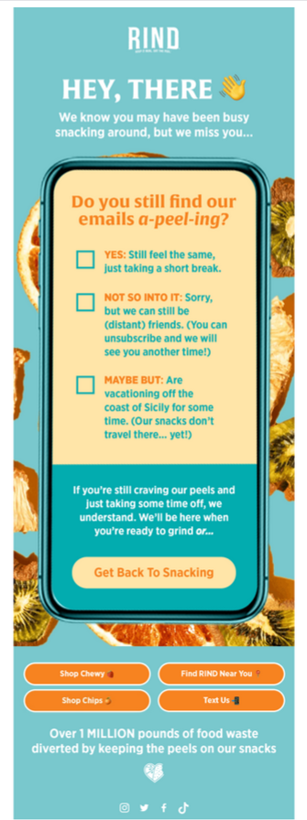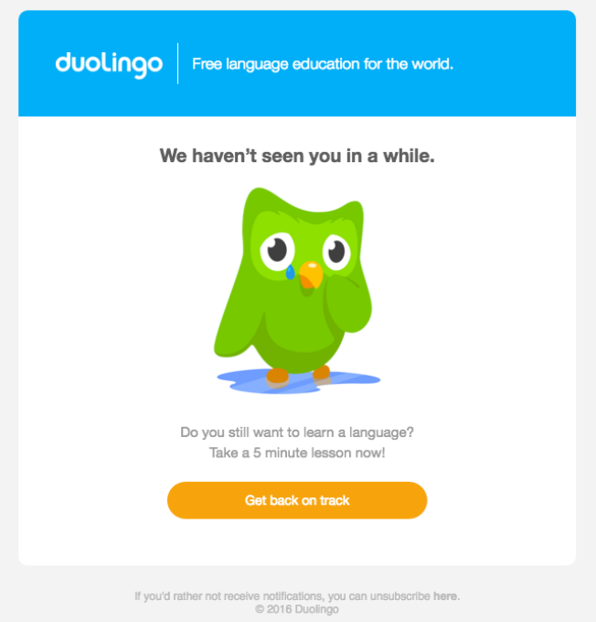- Home
- Email Tips and Tricks
- Win-Back Emails: Bring Your Cu ...

We all get distracted. And sometimes we stay off course for a while. So, there’s no crime in reminding people that they forgot something important. Especially if this “important” was shopping at your website.
Here, win-back emails can come to help. Designed to re-engage customers with your business when they get off track for a while, these emails should be in the toolkit of every marketer.
A missed opportunity, a forgotten subscription or a lost interest in company’s news – these messages are what’s needed for turning inactivity into engagement and remind your audience why they loved you in the first place.
In this article, we’ll explore what makes a customer win-back email truly effective and how you can use this strategy to keep your customers close, even when they have wandered away for a while.
What Is a Win-Back Email?
In a nutshell, a win-back email is a friendly nudge to customers who’ve gone quiet. It is designed to revive interest and remind them why they were drawn to your brand in the first place. Win-back emails are designed in a way that taps into customers’ sentiments. In the end, something like “We miss you, and we’d love to have you back” does not sound like a sale. Rather, it shows customers that they are remembered and that their presence is appreciated.
The goal of a win-back email campaign is to turn inactive relationships with customers into active ones. A thoughtful (or sentimental) message that acknowledges their absence or shows sincere regret about a relationship being interrupted is a great opportunity to remind them about your business, that they was once loved. Sometimes, a small incentive, like a special discount or a “welcome back” note, can be just the spark your customers need. And by highlighting what’s new or exciting has happened since their last visit, you give them a reason to rediscover what made them choose you in the first place.
Win-Back Emails vs. Re-Engagement Emails
Win-back emails serve a similar purpose to re-engagement emails, and one might wonder: what’s the difference between the two? While it’s true that both types of emails share a common goal, they nonetheless possess substantial differences:
| Aspect | Win-back emails | Re-Engagement Emails |
|---|---|---|
| Purpose | Targeted to bring back customers who have been inactive for a specific period and may have stopped interacting with the brand. | Focused on re-engaging less active or recently disengaged subscribers before they become fully inactive. |
| Timing | Sent after a customer or subscriber has shown no engagement or purchase activity for an extended period (often months). | Sent to customers who have shown recent dips in activity, such as lower engagement or opening rates, within a few weeks or months. |
| Typical Content | Focuses on reminding customers of their positive past experiences with the brand, with offers like discounts, incentives, or loyalty points. | Often includes updates about new features, popular products, or content they might have missed, along with a gentle call to action. |
| Main Objective | Reconnect inactive customers and encourage them to return, make a purchase, or visit the website. | Boost engagement before the subscriber becomes inactive; increase interaction rates like opens, clicks, or reads. |
| Incentives | Typically includes a strong incentive (e.g., discount, exclusive offer) to provide motivation for coming back. | May include softer incentives or simply highlight recent updates and benefits, focusing on re-sparking interest. |
Best Practices for Creating Effective Win-Back Emails
Win-back emails are delicate matters. It is important to find the right balance between gentle encouragement and genuine appreciation. Here are some best practices to help you craft messages that feel welcoming, but not intrusive:
First, start with a personalized touch. Address the recipient by name, and acknowledge that it’s been a while since their last interaction. A simple, warm opening—like “We’ve missed you, Jake!”—makes the email feel genuine. Personalization shows that you remember them and noticed their absence.
Next, give them a good reason to come back. Always remember that people love a good deal. It can be a limited-time offer, a discount, or an incentive. Highlighting this offer with bold or colorful text to make it pop and make your chances for winning back your customers a bit bigger.
Timing matters with all email campaigns, with customer win-back emails it is even more crucial. Avoid sending a win-back email too soon after their last purchase or interaction, as this can feel pushy. Instead, let a bit of time pass—say, a few months. This gives your email more relevance, as it’s been long enough for them to consider reconnecting.
Showcasing something new and exciting is another good move. If you’ve launched new products, updated features, or have something popular that they might have missed, mention it here. This can make the email feel less like a sales pitch and more like an exciting update.
Lastly, keep the tone warm and inviting. A win-back email should make your customers feel like they’ve just rediscovered long forgotten joy and excitement. It shall make them question “How could I leave behind something that great?” Like this their return will be more than natural – it will be exciting.
Advanced Practices for Win-Back Emails
1. Behavior-Based Personalization
If a customer frequently purchased a particular product or abandoned items in their cart, mention that in your win-back email. For example, “Still thinking about those running shoes?” or “We’ve added new features to your favorite app since your last visit!” People respond better when the content feels like it was made for them specifically. So, why not using it for your advantage?
2. Dynamic Content Blocks
Dynamic content allows different sections of your email to adapt based on the recipient’s data. For example, you could showcase product recommendations tailored to each customer, highlight specific loyalty points they’ve earned, or even change the CTA based on their last interaction. It is another way to personalize emails and make them feel tailor-made.
3. A/B Testing for Continuous Optimization
Don’t just assume you know what will work best—test it. Run A/B tests on your subject lines, CTA placement, offers, or even email design. Does a humorous subject line perform better than a straightforward one? Does bold design attract more attention than a minimalistic one? You never know until you try.
4. Offer Tiered Incentives
If your initial win-back attempt doesn’t work, don’t give up. Implement a tiered incentive strategy. Start with a modest offer, like 10% off, and follow up with a stronger incentive if they remain inactive. Gradually escalating incentives prevent you from over-discounting while giving customers a reason to reconsider. This approach also ensures that you do not leave potential revenue on the table by stopping after just one attempt.
5. Highlight Social Proof and User-Generated Content
Sometimes, what inactive customers need is a reminder of how much others love your brand. Include testimonials, product reviews, or photos from real customers in your win-back emails. Social proof is connected to people’s fear of missing out (FOMO). Seeing others enjoy your product or service creates a sense of belonging, making more people want to become a part of your brand community.
Real-Life Examples of Win-Back Emails and Analysis
1. Rind

A little wordplay goes a long way, and RIND nails it with their “Do you still find our emails a-peel-ing?” win-back email campaign. The lighthearted tone, paired with fun, customizable responses like “Yes, still feel the same” or “Not so into it,” puts the power in the recipient’s hands while keeping the brand’s original personality front and center.
The bright design and bold CTA make it easy to re-engage, while additional callouts at the bottom provide flexible options to explore.
So, even if users opt out, the playful vibe ensures they still feel part of the RIND community.
2. Duolingo

This Duolingo win-back email example uses minimal text but a very eloquent picture that immediately makes you feel guilty for missing your lessons. The teary-eyed owl says it all—your absence has been noticed, and it’s time to get back on track.
Without overloading the reader, the message asks hopefully: “Do you still want to learn a language?” This friendly nudge comes with a simple solution—just a 5-minute lesson to ease back into the habit. The “Get back on tack” CTA makes re-engaging feel like the easiest decision you’ll ever make.
3. Google
Here Google uses a similar strategy—little text, but the picture says a million words instead.
There’s something universally disarming about animals, especially when they look this sad and lost. It’s a clever psychological tool: we’re naturally drawn to creatures that evoke empathy.
The combination of a doggy visual and a gentle reminder turns what could be a mundane request into a heartfelt interaction. It’s proof that sometimes, a well-placed pup can do more for your win-back email campaign than the most perfectly crafted copy ever could.
4. Framebridge
To Sum Up
Winning back your customers can be as hard as trying to reignite romantic feelings that have faded. It requires imagination, tact, and slight persuasion—all combined. Win-back emails are your chance to remind your audience of the connection they once had with your brand and why it’s worth reigniting.
Approach your once-customers with care, a little creativity, and a clear value proposition. In this case your goal is to reawaken that initial excitement and turn a quiet inbox into an engaged one. When done right, win-back campaigns don’t just recover lost customers, but rebuild loyalty, showing that even after some time apart, the best journeys are the ones worth continuing together.
